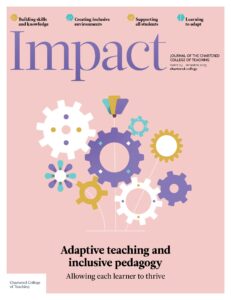Harnessing music psychology and music therapy to support social and emotional development in children

JANOS FABIAN, DIRECTOR OF MUSIC, ST EDMUND’S SCHOOL, UK; PHD MUSIC PSYCHOLOGY RESEARCHER, UNIVERSITY OF LEEDS, UK
Music has long been recognised for its power to evoke emotion and facilitate human connection. In recent years, research has increasingly highlighted the role of music psychology and music therapy in supporting children’s social and emotional development (Rus et al., 2024). By integrating music into educational and therapeutic practices, caregivers and educators can foster emotional regulation, empathy, social skills and resilience in young learners (Gold et al., 2019).
Music stimulates multiple areas of the brain, enhancing cognitive, emotional and social functions (Koelsch, 2014). Recent studies from the fields of education, music and psychology have found that engaging with music can modulate stress responses and improve mood regulation (Magee, 2016). In children, these effects are especially pronounced, aiding in the development of neural pathways associated with emotional processing and social cognition (Magee, 2016). One way in which this occurs is through music’s ability to regulate the autonomic nervous system, reducing stress levels (Koelsch, 2014). Lower stress levels can enhance social interactions by decreasing anxiety and increasing emotional availability. Additionally, music-making, particularly in group settings, fosters joint attention, turn-taking and social bonding, all of which are crucial components of social cognition (Hanna-Pladdy and MacKay, 2011).
Neuroscientific studies suggest that music activates the brain regions involved in emotional and social processing, such as the amygdala, prefrontal cortex and mirror neuron system (Molnar-Szakacs and Overy, 2006). These regions are critical for understanding others’ emotions and responding appropriately in social contexts. Furthermore, shared musical experiences, such as singing in a choir or playing in an ensemble, promote group cohesion and a sense of belonging, which are essential for social cognitive development (Hanna-Pladdy and MacKay, 2011).
Music therapy employs evidence-based interventions tailored to individual needs, whether addressing anxiety, grief or social deficits (Rickson and McFerran, 2014). Techniques such as songwriting, improvisation and rhythmic entrainment allow children to express themselves creatively while working through emotional and psychological challenges. For instance, in group therapy, music becomes a shared language that builds trust and fosters cooperation among participants (Sharda et al., 2018).
The role of music in emotional development
From infancy, music acts as a medium for emotional exploration. Lullabies, for example, help infants to regulate emotions by calming and soothing them, establishing a foundation for trust and secure bonding with caregivers (Bunt and Stige, 2017). As children grow, musical activities such as singing and interactive play can enhance their ability to identify and express feelings, a critical component of emotional intelligence (Hallam, 2010). Susan Hallam’s research highlights that musical engagement, particularly from an early age, supports the development of emotional intelligence by refining children’s ability to recognise, interpret and regulate emotions (Hallam, 2010). Through structured musical experiences such as singing, movement and ensemble participation, children learn to associate sound with emotional meaning, strengthening their capacity for empathy and social understanding (Hallam, 2010). Additionally, Hallam (2016) emphasises that repeated exposure to music enhances neural plasticity, fostering connections between cognitive and emotional processing centres in the brain, which are crucial for social interaction and emotional wellbeing.
Music also provides a safe avenue for children to explore complex emotions such as fear, joy or disappointment (Juslin and Sloboda, 2011). Engaging with songs that include dramatic or playful narratives, such as ‘Pop Goes the Weasel’, helps children to navigate feelings of suspense and release, teaching them to manage emotional tension. Research indicates that through these playful narratives, children who engage in music and movement activities demonstrate improved self-regulation skills, crucial for long-term mental health and academic success (Sena Moore, 2017).
For children facing emotional challenges, music therapy offers structured support. Music therapists employ techniques such as songwriting, rhythm-based activities and improvisation to help children to articulate feelings and develop coping mechanisms (Saarikallio and Erkkilä, 2007). This approach is particularly effective for children who find traditional talk therapies intimidating. Studies by Gold et al. (2019) indicate that music therapy provides a non-verbal medium for emotional expression, reducing anxiety and making therapeutic engagement more accessible for children who struggle with verbal communication. Furthermore, research by Kim et al. (2008) demonstrates that improvisational music therapy helps children with emotional and social difficulties by fostering a safe, structured environment for self-expression. Additionally, Bunt and Stige (2017) highlight that music therapy can enhance emotional resilience and self-regulation, making it especially beneficial for children who experience difficulty in articulating their thoughts and feelings in traditional speech therapy settings.
Social benefits of music
Music inherently fosters social interaction. Group activities such as singing in choirs or playing in ensembles teach children essential social skills, including turn-taking, cooperation and leadership. The structured nature of music mirrors societal rules, making it a natural tool for practising social norms (Sena Moore and Hanson-Abromeit, 2015).
For children with social difficulties, music therapy provides a supportive environment in which to build interpersonal skills (Blasco-Magraner et al., 2021). Musical games and exercises can help children with autism, for example, to increase their awareness of others, express empathy and improve peer interactions (Geretsegger et al., 2014). By creating opportunities for shared experiences, music therapy enhances a child’s sense of belonging and community.
Integrating music into the wider educational setting
The integration of music into classrooms is a powerful way in which to support social-emotional learning (SEL). Teachers can use songs to help children to understand and label emotions, fostering emotional literacy. Hallam (2010) suggests that singing in the classroom can enhance children’s ability to recognise and express emotions by linking sound patterns with emotional meaning. Barrett (2011) highlights that songs with narrative elements provide children with a framework with which to explore emotions in a safe and structured way, improving their emotional vocabulary and self-awareness. Additionally, Welch et al. (2014) found that singing in educational settings fosters SEL by promoting empathy, emotional regulation and interpersonal connection. Rhythmic activities, such as clapping games, can promote attentiveness and impulse control, while collaborative musical projects encourage teamwork (Rus et al., 2024).
Recent models, such as the access-awareness-agency (AAA) framework, emphasise the importance of making music accessible to all students (Saarikallio, 2021). This model highlights how music can cultivate awareness of emotions and agency in social interactions, equipping children with tools with which to navigate relationships and challenges effectively.
Music therapy in clinical and educational settings
Clinical applications of music therapy extend to children dealing with trauma, anxiety or behavioural issues. For these children, music therapy offers a creative, non-threatening platform for self-expression (Porter et al., 2017). Techniques such as rhythmic drumming or composing melodies can help to reduce stress and build resilience. Studies show that music therapy also aids in the development of self-esteem and emotional flexibility, particularly in children experiencing grief or social isolation (Gold et al., 2019).
In educational contexts, incorporating music-based SEL activities can improve classroom dynamics (Rickson and McFerran, 2014). For example, using music to signal transitions between tasks or to de-escalate heightened emotions can create a calmer and more focused learning environment. Additionally, music interventions can address the specific needs of children with learning disabilities or attention disorders, enabling them to engage more fully with peers and the curriculum (Lu et al., 2021).
Practical strategies for parents and educators
To harness the benefits of music for social and emotional development:
- Incorporate music daily: Singing, dancing or playing instruments can be woven into daily routines to teach emotional and social skills
- Engage in musical play: Structured activities such as call-and-response songs or rhythm games provide enjoyable opportunities for practising social interactions
- Create safe spaces: Use music to build environments where children feel free to explore and express emotions (choirs, instrumental practice sessions, performing arts extra-curricular sessions)
- Seek professional guidance: For children with specific needs, professional music therapists can design targeted interventions.
Conclusion and future directions
The evidence supporting the role of music in fostering children’s social and emotional development is compelling. Whether through formal therapy or everyday musical interactions, music offers a unique and effective way in which to help children to navigate their emotional worlds and build meaningful relationships. As research continues, it is crucial to expand access to music-based interventions, particularly for underserved communities, ensuring that all children can benefit from this powerful tool.
By prioritising music in therapeutic and educational settings, we can empower children to thrive socially and emotionally, equipping them with skills that will last a lifetime.
- Barrett MS (2011) Musical narratives: A study of a young child’s identity work in and through music-making. Psychology of Music 39(4): 403–423.
- Blasco-Magraner JS, Bernabe-Valero G, Marín-Liébana P et al. (2021) Effects of the educational use of music on 3-to 12-year-old children’s emotional development: A systematic review. International Journal of Environmental Research and Public Health 18(7): 3668.
- Bunt L and Stige B (2017) Music Therapy: An Art Beyond Words. Abingdon: Routledge.
- Geretsegger M, Elefant C, Mössler KA et al. (2014) Music therapy for people with autism spectrum disorder. Cochrane Database of Systematic Reviews 6: CD004381.
- Gold C, Voracek M and Wigram T (2019) Effects of music therapy for children and adolescents with psychopathology: A meta-analysis. Psychology of Music 47(6): 800–822.
- Hallam S (2010) The power of music: Its impact on the intellectual, social and personal development of children and young people. International Journal of Music Education 28(3): 269–289.
- Hallam S (2016) The impact of actively making music on the intellectual, social and personal development of children and young people: A summary. Voices: A World Forum for Music Therapy 16(2). DOI: 10.15845/voices.v16i2.884.
- Hanna-Pladdy B and MacKay A (2011) The relation between instrumental musical activity and cognitive aging. Neuropsychology 25(3): 378.
- Juslin PN and Sloboda J (2011) Handbook of Music and Emotion: Theory, Research, Applications. Oxford: Oxford University Press.
- Kim J, Wigram T and Gold C (2008) The effects of improvisational music therapy on joint attention behaviors in autistic children: A randomized controlled study. Journal of Autism and Developmental Disorders 38: 1758–1766.
- Koelsch S (2014) Brain correlates of music-evoked emotions. Nature Reviews Neuroscience 15(3): 170–180.
- Lu G, Jia R, Liang D et al. (2021) Effects of music therapy on anxiety: A meta-analysis of randomized controlled trials. Psychiatry Research 304: 114137.
- Magee WL (2016) The future of medical music therapy in neuro-rehabilitation. In: Dileo C (ed) Envisioning the Future of Music Therapy. Temple University, pp. 81–86. Available at: https://scholarshare.temple.edu/server/api/core/bitstreams/6736d7e6-5b9a-4fb1-8f99-8024d75e3b0d/content (accessed 5 March 2025).
- Molnar-Szakacs I and Overy K (2006) Music and mirror neurons: From motion to emotion. Social Cognitive and Affective Neuroscience 1(3): 235–241.
- Porter S, McConnell T, Clarke M et al. (2017) Music therapy for children and adolescents with behavioral and emotional problems: A controlled trial. The Journal of Child Psychology and Psychiatry 58(5): 586–594.
- Rickson DJ and McFerran K (2014) Music therapy in special education: Where are we now? Journal of Music Therapy 51(3): 232–261.
- Rus A, Dohotaru AI, Catalano H et al. (2024) Development of social-emotional skills in early education through musical activities: Experimental study. Educatia 21 28: 13.
- Saarikallio S (2021) The access-awareness-agency (AAA) model of music-based social-emotional competence (MuSEC). Music & Science 2(20130400): 205920431881542.
- Saarikallio S and Erkkilä J (2007) The role of music in adolescents’ mood regulation: A study of emotional and social processes. Psychology of Music 35(1): 88–109.
- Sena Moore K (2017) Understanding the influence of music on emotions: A historical review. Music Therapy Perspectives 35(2): 131–143.
- Sena Moore K and Hanson-Abromeit D (2015) Theory-guided therapeutic function of music to facilitate emotion regulation development in preschool-aged children. Frontiers in Human Neuroscience 9: 572.
- Sharda M, Tuerk C, Chowdhury R et al. (2018) Music improves social communication and brain connectivity outcomes in children with autism: A randomized controlled trial. Journal of Autism and Developmental Disorders 48(10): 3193–3203.
- Welch GF, Himonides E, Saunders J et al. (2014) Singing and social inclusion. Frontiers in Psychology 5: 803.










